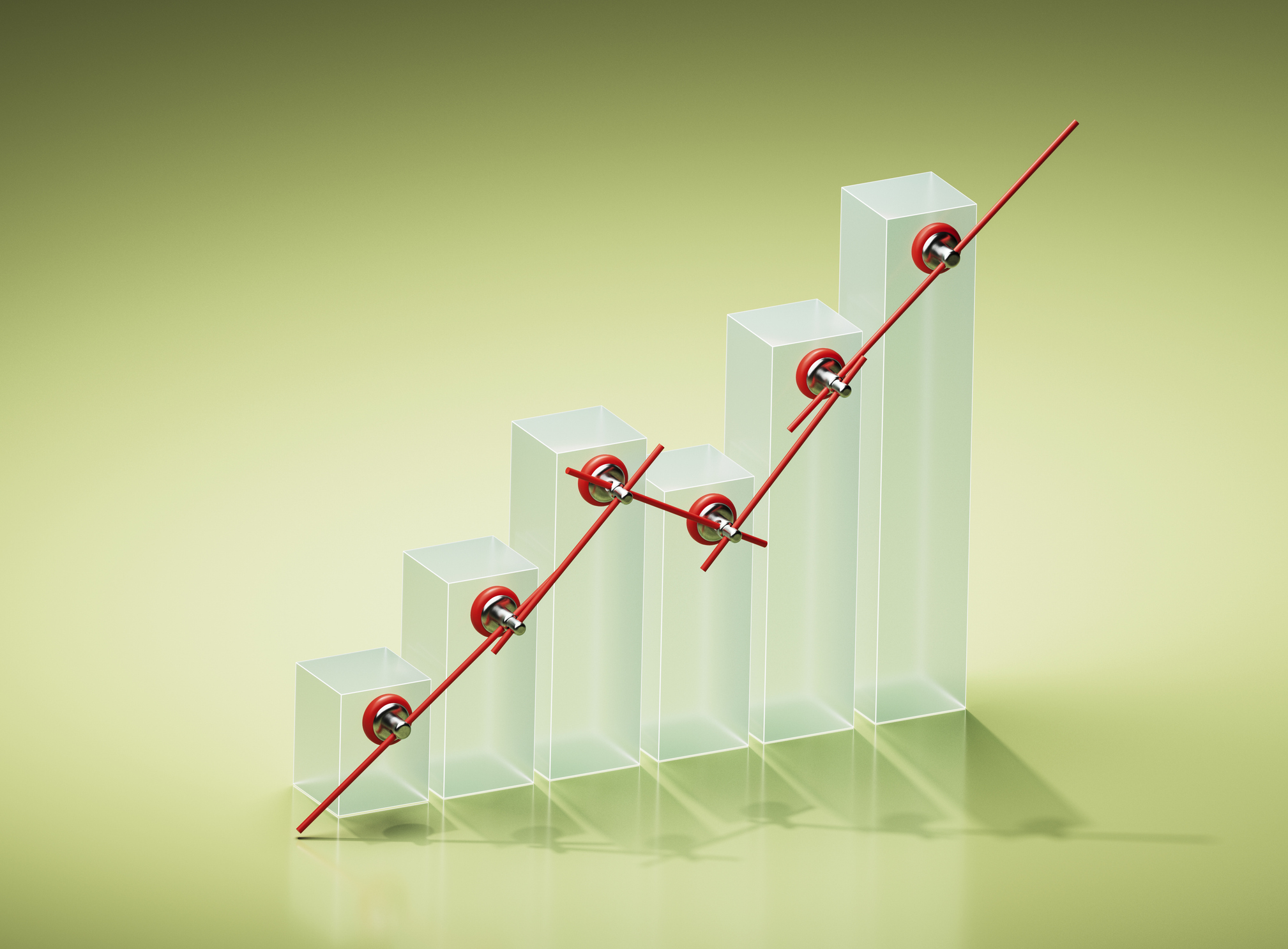Stock Market Volatility, Geopolitics and Midterm Elections – Oh My! Should Investors Be Worried?
Let's break down some concerns on investors' minds this year and see where that leaves us going forward. The situation may not be as scary as it sounds.


If you've spent any time watching market news this year, you've likely experienced the roller coaster of recent stock volatility. I've had a lot of questions about whether it's different this time, or whether we're heading for a tough correction.
There are a lot of factors involved in this year’s volatility, but that doesn’t mean it’s all bad news out there.
What’s going on here?
A couple of the major drivers of volatility this year have been centered around economic uncertainty and geopolitics.
From just $107.88 $24.99 for Kiplinger Personal Finance
Become a smarter, better informed investor. Subscribe from just $107.88 $24.99, plus get up to 4 Special Issues

Sign up for Kiplinger’s Free Newsletters
Profit and prosper with the best of expert advice on investing, taxes, retirement, personal finance and more - straight to your e-mail.
Profit and prosper with the best of expert advice - straight to your e-mail.
The Federal Reserve has started reining in its generous policies (like low interest rates), which it implemented after the financial crisis. That could have an impact on lending rates both at home and abroad. While the Fed is implementing more conservative policies as a result of a strengthening U.S. economy, there are market observers who worry about implications for other economies – and for the stability of the U.S. economy should our trade relationships change significantly.
As the U.S. renegotiates NAFTA and engages in trade negotiations with China — a process that has been somewhat volatile — markets have been constantly trying to predict and absorb the potential implications.
Geopolitics are also a factor. From OPEC statements that have led to uncertainty about future oil prices to the complicated situation in North Korea, we’ve seen varying degrees of hope, confusion and volatility. More recently, political turmoil in Italy brought additional (and renewed) fears about prospects for the eurozone and even the stability of the European Union itself.
The historical context
Finally, our own political climate could be having an important impact – but not in the way you might think.
Historically speaking, midterm election years are more volatile than other years. In fact, in eight out of the last nine midterm election years, the S&P 500 lost between 7% and 20%. Through April 2018, the S&P 500 was down about 10% from its high in January. However, as of this writing, the index is still slightly positive for the year.
If you ask me, that on its own tells you something. Markets don’t like uncertainty: The more there is, the more volatile things tend to become. In midterm years, the political order could be upended and shift the balance of governance – which could shift the balance of policy and predictability.
But, taken together, all these factors have made for a year where we’ve seen market swings that are more numerous and more pronounced than anything we experienced in the previous two years.
In fact, according to Bloomberg, down days are 24% bigger in magnitude this year than up days — a difference in performance that hasn’t been recorded since 1948. Whether you feel confident about your understanding of what’s going on or not, it’s enough to give anyone pause.
Should you be worried?
All that said, there’s still a lot of good news that sometimes gets drowned out by the bad.
Large companies are doing very well in terms of earnings and activity, and implied volatility going forward is actually pretty low compared with historical averages. While economic growth in the first quarter came in lower than expected, rising 2.2% on an annualized basis, it was still above the long-term average of 2%. There are indications that second-quarter growth will be even stronger.
There could also be important benefits for businesses (and thus investors) thanks to a trimming down of the Dodd-Frank Act, which had put more stringent rules on banks following the financial crisis. I believe small and midsized banks will now find it easier to operate — and to lend money.
Additionally, with lower taxes on corporations and repatriated profits because of the new tax plan, I believe we’re entering a period where companies will be able to invest in their operations, expand and grow. This is potentially very good news for investors.
Global economic prospects are also positive. In fact, European markets have been more stable than ours this year as the European Union builds economic momentum.
Here’s what I think
Even if trade tensions continue and even if geopolitics remain challenging, the prospects — both at home and abroad — are positive. I believe we’re closer to the bottom of this challenging period than to the top, and I think it’s important to look beyond a few months’ worth of volatility to get a real sense of where we are and where we’re going.
Of course, markets can surprise anyone, and there’s always a chance of a curveball throwing all our collective predictions off course. But in this situation, I think the numbers speak for themselves. If you have a longer-term investment time horizon and a prudent investment strategy that’s suitable for you, I don’t think volatility should be at the top of your mind.
Written by Bradford Pine with Anna B. Wroblewska.
Profit and prosper with the best of Kiplinger's advice on investing, taxes, retirement, personal finance and much more. Delivered daily. Enter your email in the box and click Sign Me Up.

Brad Pine is a wealth adviser and president of Bradford Pine Wealth Group, based in Garden City, N.Y. BP Wealth Group assists individuals and entrepreneurs to create wealth, simplify their lives and plan for retirement. Honesty, integrity and reliability are the foundations of Pine's investment philosophy.
-
 The SEC Is Concerned for Older Investors and Retirement Savers. Here's What You Should Know
The SEC Is Concerned for Older Investors and Retirement Savers. Here's What You Should KnowThe SEC focusing on older investors, retirement and college savers, and private securities. Here's how those changes impact you.
-
 Vesting, Catch-Ups and Roths: The 401(k) Knowledge Quiz
Vesting, Catch-Ups and Roths: The 401(k) Knowledge QuizQuiz Test your understanding of key 401(k) concepts with our quick quiz.
-
 Why You Should Pay Attention to Company Guidance
Why You Should Pay Attention to Company GuidanceUnderstanding how corporate profit forecasts affect analysts’ estimates and stock ratings can help you make investment decisions.
-
 How to Protect Yourself and Others From a Troubled Adult Child: A Lesson from Real Life
How to Protect Yourself and Others From a Troubled Adult Child: A Lesson from Real LifeThis case of a violent adult son whose parents are in denial is an example of the extreme risks some parents face if they neglect essential safety precautions.
-
 To Build Client Relationships That Last, Embrace Simplicity
To Build Client Relationships That Last, Embrace SimplicityAs more automation becomes the norm, you can distinguish yourself as a financial professional by using technology wisely and prioritizing personal touches.
-
 Client Demand Is Forcing Financial Advisers to Specialize: How to Deliver
Client Demand Is Forcing Financial Advisers to Specialize: How to DeliverThe complexity of wealthy clients' needs — combined with AI and consumer demand — suggests the future of financial planning belongs to specialized experts.
-
 A Financial Planner Takes a Deep Dive Into How Charitable Trusts Benefit You and Your Favorite Charities
A Financial Planner Takes a Deep Dive Into How Charitable Trusts Benefit You and Your Favorite CharitiesThese dual-purpose tools let affluent families combine philanthropic goals with advanced tax planning to generate income, reduce estate taxes and preserve wealth.
-
 A 5-Step Plan for Parents of Children With Special Needs, From a Financial Planner
A 5-Step Plan for Parents of Children With Special Needs, From a Financial PlannerGuidance to help ensure your child's needs are supported now and in the future – while protecting your own financial well-being.
-
 How Financial Advisers Can Best Help Widowed and Divorced Women
How Financial Advisers Can Best Help Widowed and Divorced WomenApproaching conversations with empathy and compassion is key to helping them find clarity and confidence and take control of their financial futures.
-
 A Wealth Adviser Explains: 4 Times I'd Give the Green Light for a Roth Conversion (and 4 Times I'd Say It's a No-Go)
A Wealth Adviser Explains: 4 Times I'd Give the Green Light for a Roth Conversion (and 4 Times I'd Say It's a No-Go)Roth conversions should never be done on a whim — they're a product of careful timing and long-term tax considerations. So how can you tell whether to go ahead?
-
 A 4-Step Anxiety-Reducing Retirement Road Map, From a Financial Adviser
A 4-Step Anxiety-Reducing Retirement Road Map, From a Financial AdviserThis helpful process covers everything from assessing your current finances and risks to implementing and managing your personalized retirement income plan.